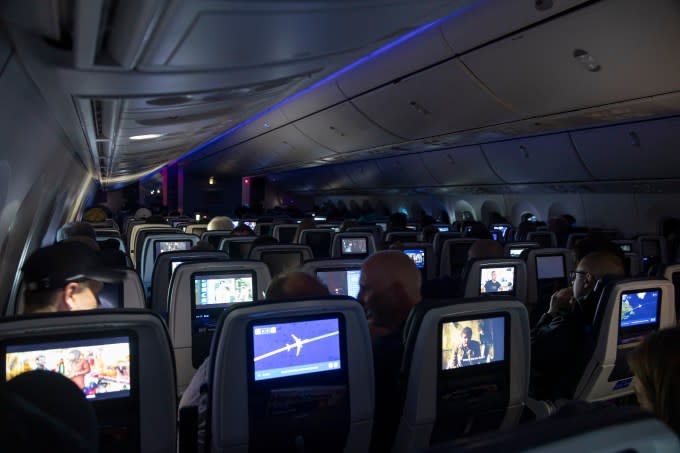Why United chose SpaceX's Starlink to power its free Wi-Fi
Late last week, United Airlines announced that it signed an agreement with Elon Musk's SpaceX to bring its Starlink internet service to its entire fleet and — for the first time — offer free Wi-Fi to all passengers. To dig a bit deeper into why United went with Starlink, what that rollout will look like and what it means for passengers and crew, we talked to United's Chief Customer Officer Linda Jojo.
"If I could have done this change earlier, I certainly would have, because we're proud of a lot of things, but we do think that our customers deserve a better Wi-Fi experience than the one they have today," Jojo told me when I asked why the company is changing providers now.
Currently, United is using a mix of four different providers — Gogo, Thales, Panasonic and ViaSat — all with different capabilities and limitations. You may find yourself on one flight that lets you stream video, for example, while your connecting flight only supports basic web surfing. While the airline has attempted to unify these systems behind a single sign-in experience, Jojo admitted that it's not always possible to shield customers from the underlying complexity.
Meanwhile, the expectation, in part set by United's competitors like Delta Air Lines, is that Wi-Fi on flights should be free. Yet United's current set of providers simply didn't have the capacity that would've allowed for offering free Wi-Fi to everyone on the plane, Jojo said.

"If we went free with what we had, we were going to enable a worse experience than what we had with the paid option, because the paid was just enough friction — $8 for a [MileagePlus] member — to say 'I'm going to be really intentional about connecting," she said. "We know the architecture and the setup today is not going to be good enough."
The search for a better solution led United to consider low Earth orbit (LEO) satellites. They are, by definition, closer to the aircraft than those in a geosynchronous orbit, and hence can offer lower latencies, more capacity, and higher speeds. And when it comes to offering satellite-based Internet access with global coverage and enough bandwidth, Starlink is pretty much the only game in town.
"If we were going to try it, we were going to try it with Starlink," Jojo said. "We first started looking at it for our regional fleet to see if we were going to try it out. And we quickly said, 'there's nothing to try out here. We can see that it's going to work.' We could see what JSX and others were doing. We could tell from where the satellites were, that the coverage was there."
Earlier this year, United started its negotiations with Starlink to bring its hardware onto its planes. Jojo noted that since other airlines like Hawaiian (which is now merging with Alaska Airlines) are going through a similar process right now, that should speed up the certification process as well.
Interestingly, United plans to get the actual retrofits done within two days — and may even be able to split this up into two parts, where the process starts while the aircraft is in base for one night, is suspended as the plane goes into flight for the day, then completed on the second night. Typically, a process like this would happen during a more involved multi-day maintenance check (and at times, that may still be the best time to install the Starlink hardware).

As it turns out, the actual satellite terminal is much smaller and easier to set up than the ones United currently uses. "It's another great example of where Starlink is pretty incredible. It's really well engineered. It's a very simple product. It's much simpler than what we already have on the airplane," Jojo said. "The [satellite systems that use] geosynchronous orbits have moving parts inside. The antennas track the satellites as the plane is flying. Starlink doesn't need that. There's no more moving parts inside the Starlink modules. It's very modular."
Still, with over 1,000 planes, this rollout will take a while and if there's one thing Jojo stressed during our conversation it's that she would love for it to move along as fast as possible. Still, the first passenger flight with Starlink Wi-Fi won't take off until sometime in 2025.
United is going through this process while it is also giving its cabins a refresh, with the seatback screens that went missing a decade or so ago making a comeback. The idea here is to make those systems smarter and more powerful as well once they are connected to the speedier and more reliable Wi-Fi.
"We had been thinking about improving the Wi Fi experience all through this process," Jojo said about the cabin refresh. "If anything, the Wi-Fi piece is a fast follower to the seat back piece and so we're going to catch up and go."
That may mean being able to start watching an in-flight movie on a first flight and then continuing that move on your connecting flight. It may simply mean being able to log into your Netflix account to watch a movie, but United may also look at bringing more interactive experience to the seatback screens — or may multi-screen gaming experiences that also use your smartphone.
For the crew, United is already using its existing networks to help its crew communicate with each other and their ground teams. With Starlink in place, they'll be able to go from text-based messaging to using video and voice, both to talk to each other, but also to maybe send a video of some equipment that'll need repair after landing, for example. Since modern aircraft are full of sensors, the team may also be able to relay more of that to the ground in real time, including for preventative maintenance.

 Yahoo Lifestyle
Yahoo Lifestyle 
